Abstract
Brain glucose metabolism is impaired during hypoglycemia, but, if sustained, brain metabolism reverts to normal in animal models--data in man are lacking. We tested the hypothesis that adaptations occur to allow maintenance of normal rates of brain glucose uptake (BGU) following recurrent hypoglycemia in man. Twelve normal humans were studied over 4 days. On the initial day, arterial plasma glucose concentrations were decreased from 4.72 to 2.50 mmol/liter in five 0.56 mmol/liter steps. Cerebral blood flow, brain arteriovenous glucose difference, BGU, and cognitive function were quantitated at each step. BGU was initially impaired at the 3.61 mmol/liter glucose step (P = 0.04) and was antedated by increments in epinephrine that began at 4.16 mmol/liter (P = 0.03). The onset of hypoglycemic symptoms occurred during the 3.61 mmol/liter glucose step (P = 0.02), whereas tests of cognitive function generally deteriorated at the 3.05 mmol/liter step (P < 0.05). During the next 56 hr, mean glucose concentrations were kept at 2.9 +/- 0.1 mmol/liter and reached normal only during meals. The stepped clamp protocol was repeated beginning at 4.16 mmol/liter on the last day. No decrement in BGU was observed at any step; cognitive function was preserved until significantly lower glucose concentrations on the final day relative to the first (P = 0.04). Subjects remained asymptomatic of hypoglycemia until they reached a glucose concentration of 2.50 mmol/liter (P < 0.001 vs. day 1), while initial increments in all counterregulatory hormones were forestalled to lower glucose steps than on day 1. Therefore, adaptations occur that allow normal BGU and cerebral function to be maintained during recurrent systemic hypoglycemia. Counterregulatory events that should result in symptoms of hypoglycemia and increments in endogenous glucose production are prevented until extremely subnormal glucose concentrations.
Full text
PDF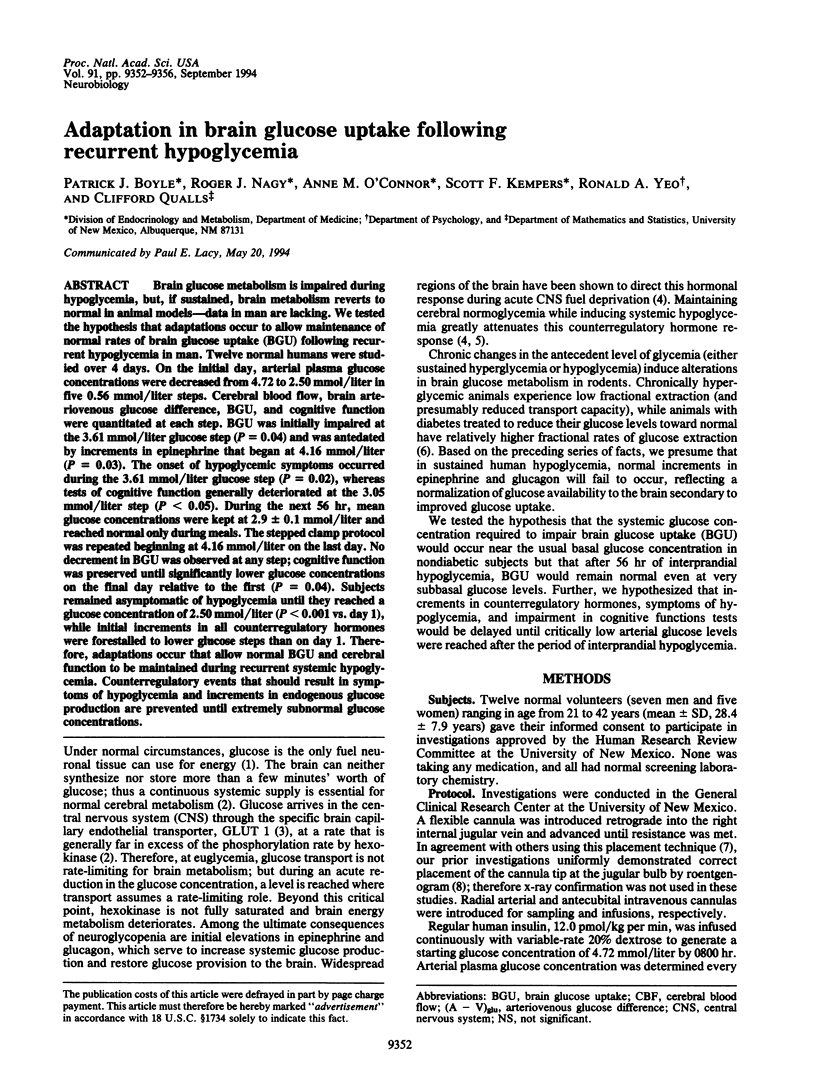
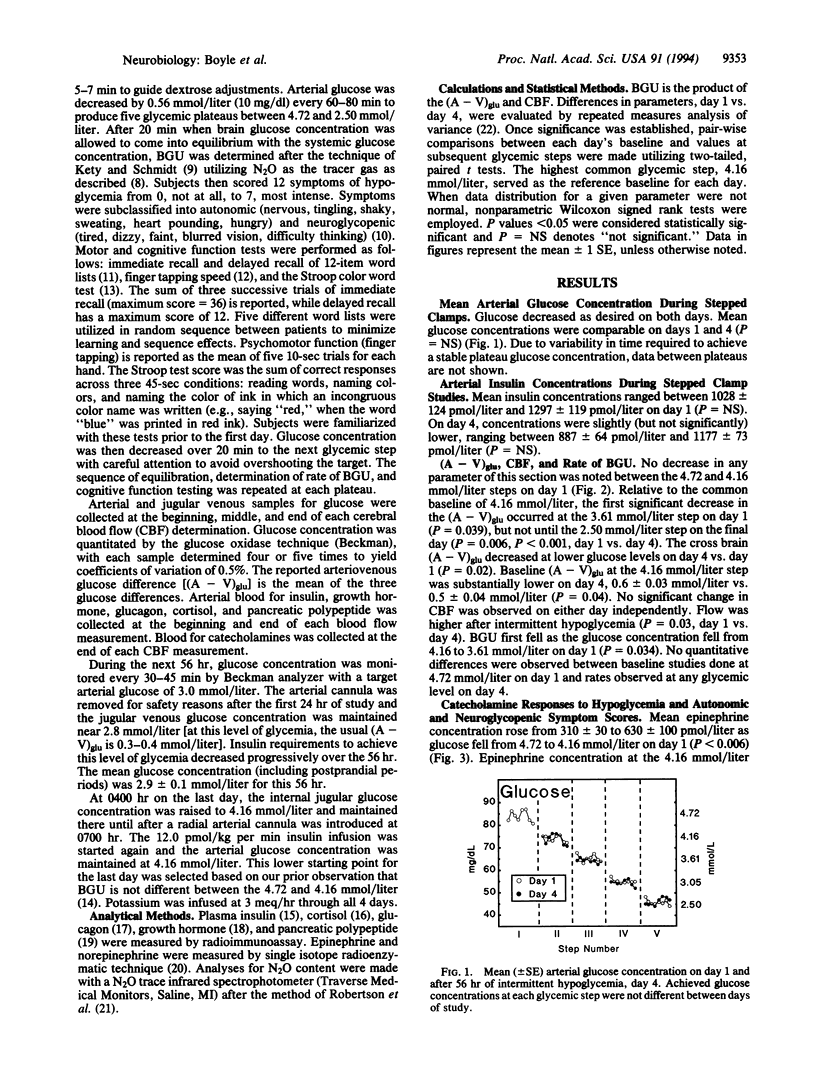
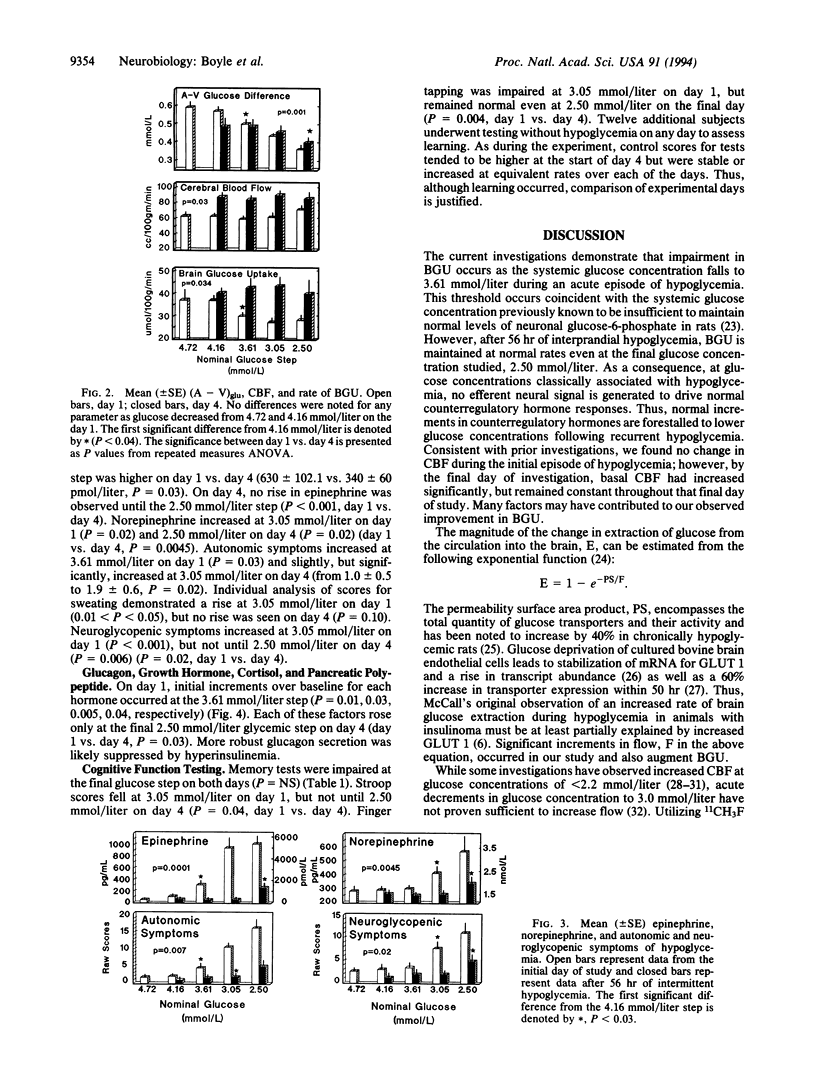
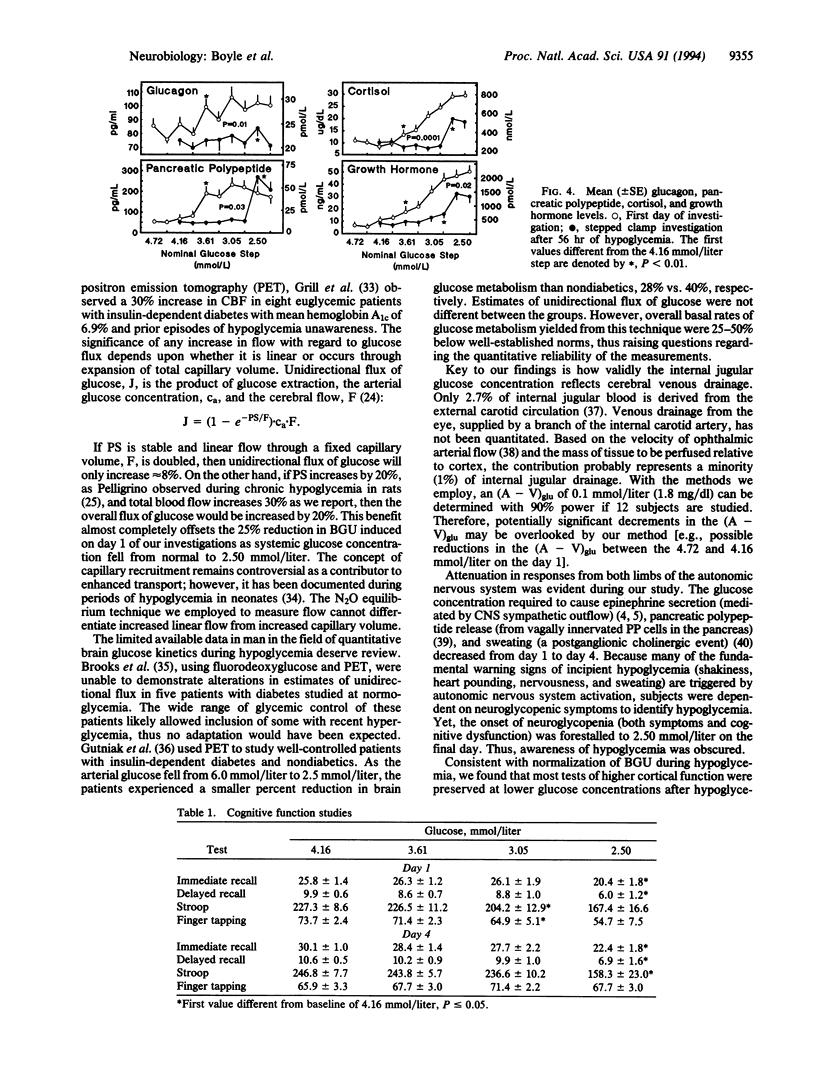
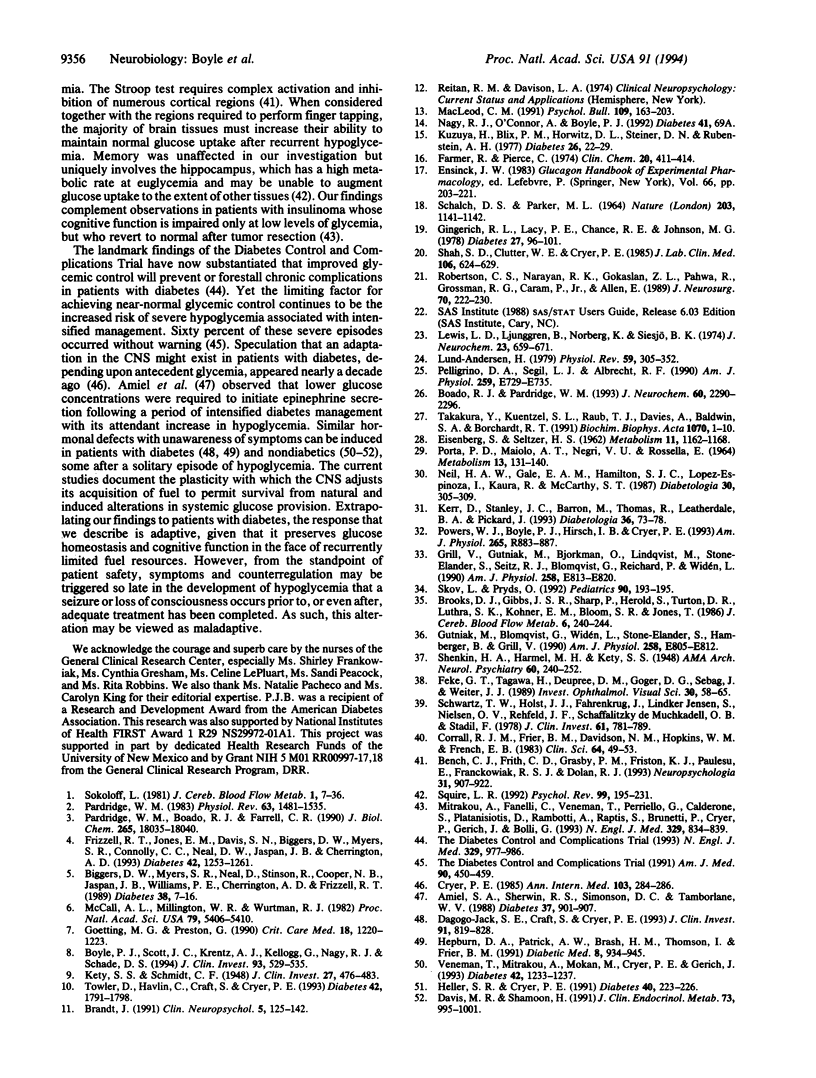
Selected References
These references are in PubMed. This may not be the complete list of references from this article.
- Amiel S. A., Sherwin R. S., Simonson D. C., Tamborlane W. V. Effect of intensive insulin therapy on glycemic thresholds for counterregulatory hormone release. Diabetes. 1988 Jul;37(7):901–907. doi: 10.2337/diab.37.7.901. [DOI] [PubMed] [Google Scholar]
- Bench C. J., Frith C. D., Grasby P. M., Friston K. J., Paulesu E., Frackowiak R. S., Dolan R. J. Investigations of the functional anatomy of attention using the Stroop test. Neuropsychologia. 1993 Sep;31(9):907–922. doi: 10.1016/0028-3932(93)90147-r. [DOI] [PubMed] [Google Scholar]
- Biggers D. W., Myers S. R., Neal D., Stinson R., Cooper N. B., Jaspan J. B., Williams P. E., Cherrington A. D., Frizzell R. T. Role of brain in counterregulation of insulin-induced hypoglycemia in dogs. Diabetes. 1989 Jan;38(1):7–16. doi: 10.2337/diab.38.1.7. [DOI] [PubMed] [Google Scholar]
- Boado R. J., Pardridge W. M. Glucose deprivation causes posttranscriptional enhancement of brain capillary endothelial glucose transporter gene expression via GLUT1 mRNA stabilization. J Neurochem. 1993 Jun;60(6):2290–2296. doi: 10.1111/j.1471-4159.1993.tb03516.x. [DOI] [PubMed] [Google Scholar]
- Boyle P. J., Scott J. C., Krentz A. J., Nagy R. J., Comstock E., Hoffman C. Diminished brain glucose metabolism is a significant determinant for falling rates of systemic glucose utilization during sleep in normal humans. J Clin Invest. 1994 Feb;93(2):529–535. doi: 10.1172/JCI117003. [DOI] [PMC free article] [PubMed] [Google Scholar]
- Brooks D. J., Gibbs J. S., Sharp P., Herold S., Turton D. R., Luthra S. K., Kohner E. M., Bloom S. R., Jones T. Regional cerebral glucose transport in insulin-dependent diabetic patients studied using [11C]3-O-methyl-D-glucose and positron emission tomography. J Cereb Blood Flow Metab. 1986 Apr;6(2):240–244. doi: 10.1038/jcbfm.1986.37. [DOI] [PubMed] [Google Scholar]
- Corrall R. J., Frier B. M., Davidson N. M., Hopkins W. M., French E. B. Cholinergic manifestations of the acute autonomic reaction to hypoglycaemia in man. Clin Sci (Lond) 1983 Jan;64(1):49–53. doi: 10.1042/cs0640049. [DOI] [PubMed] [Google Scholar]
- Cryer P. E. Does central nervous system adaptation to antecedent glycemia occur in patients with insulin-dependent diabetes mellitus? Ann Intern Med. 1985 Aug;103(2):284–286. doi: 10.7326/0003-4819-103-2-284. [DOI] [PubMed] [Google Scholar]
- Dagogo-Jack S. E., Craft S., Cryer P. E. Hypoglycemia-associated autonomic failure in insulin-dependent diabetes mellitus. Recent antecedent hypoglycemia reduces autonomic responses to, symptoms of, and defense against subsequent hypoglycemia. J Clin Invest. 1993 Mar;91(3):819–828. doi: 10.1172/JCI116302. [DOI] [PMC free article] [PubMed] [Google Scholar]
- Davis M. R., Shamoon H. Counterregulatory adaptation to recurrent hypoglycemia in normal humans. J Clin Endocrinol Metab. 1991 Nov;73(5):995–1001. doi: 10.1210/jcem-73-5-995. [DOI] [PubMed] [Google Scholar]
- Farmer R. W., Pierce C. E. Plasma cortisol determination: radioimmunoassay and competitive protein binding compared. Clin Chem. 1974 Apr;20(4):411–414. [PubMed] [Google Scholar]
- Feke G. T., Tagawa H., Deupree D. M., Goger D. G., Sebag J., Weiter J. J. Blood flow in the normal human retina. Invest Ophthalmol Vis Sci. 1989 Jan;30(1):58–65. [PubMed] [Google Scholar]
- Frizzell R. T., Jones E. M., Davis S. N., Biggers D. W., Myers S. R., Connolly C. C., Neal D. W., Jaspan J. B., Cherrington A. D. Counterregulation during hypoglycemia is directed by widespread brain regions. Diabetes. 1993 Sep;42(9):1253–1261. doi: 10.2337/diab.42.9.1253. [DOI] [PubMed] [Google Scholar]
- Gingerich R. L., Lacy P. E., Chance R. E., Johnson M. G. Regional pancreatic concentration and in-vitro secretion of canine pancreatic polypeptide, insulin, and glucagon. Diabetes. 1978 Feb;27(2):96–101. doi: 10.2337/diab.27.2.96. [DOI] [PubMed] [Google Scholar]
- Goetting M. G., Preston G. Jugular bulb catheterization: experience with 123 patients. Crit Care Med. 1990 Nov;18(11):1220–1223. doi: 10.1097/00003246-199011000-00006. [DOI] [PubMed] [Google Scholar]
- Grill V., Gutniak M., Björkman O., Lindqvist M., Stone-Elander S., Seitz R. J., Blomqvist G., Reichard P., Widén L. Cerebral blood flow and substrate utilization in insulin-treated diabetic subjects. Am J Physiol. 1990 May;258(5 Pt 1):E813–E820. doi: 10.1152/ajpendo.1990.258.5.E813. [DOI] [PubMed] [Google Scholar]
- Gutniak M., Blomqvist G., Widén L., Stone-Elander S., Hamberger B., Grill V. D-[U-11C]glucose uptake and metabolism in the brain of insulin-dependent diabetic subjects. Am J Physiol. 1990 May;258(5 Pt 1):E805–E812. doi: 10.1152/ajpendo.1990.258.5.E805. [DOI] [PubMed] [Google Scholar]
- Heller S. R., Cryer P. E. Reduced neuroendocrine and symptomatic responses to subsequent hypoglycemia after 1 episode of hypoglycemia in nondiabetic humans. Diabetes. 1991 Feb;40(2):223–226. doi: 10.2337/diab.40.2.223. [DOI] [PubMed] [Google Scholar]
- Hepburn D. A., Patrick A. W., Brash H. M., Thomson I., Frier B. M. Hypoglycaemia unawareness in type 1 diabetes: a lower plasma glucose is required to stimulate sympatho-adrenal activation. Diabet Med. 1991 Dec;8(10):934–945. doi: 10.1111/j.1464-5491.1991.tb01533.x. [DOI] [PubMed] [Google Scholar]
- Kerr D., Stanley J. C., Barron M., Thomas R., Leatherdale B. A., Pickard J. Symmetry of cerebral blood flow and cognitive responses to hypoglycaemia in humans. Diabetologia. 1993 Jan;36(1):73–78. doi: 10.1007/BF00399097. [DOI] [PubMed] [Google Scholar]
- Kety S. S., Schmidt C. F. THE NITROUS OXIDE METHOD FOR THE QUANTITATIVE DETERMINATION OF CEREBRAL BLOOD FLOW IN MAN: THEORY, PROCEDURE AND NORMAL VALUES. J Clin Invest. 1948 Jul;27(4):476–483. doi: 10.1172/JCI101994. [DOI] [PMC free article] [PubMed] [Google Scholar]
- Kuzuya H., Blix P. M., Horwitz D. L., Steiner D. F., Rubenstein A. H. Determination of free and total insulin and C-peptide in insulin-treated diabetics. Diabetes. 1977 Jan;26(1):22–29. doi: 10.2337/diab.26.1.22. [DOI] [PubMed] [Google Scholar]
- Lewis L. D., Ljunggren B., Norberg K., Siesjö B. K. Changes in carbohydrate substrates, amino acids and ammonia in the brain during insulin-induced hypoglycemia. J Neurochem. 1974 Oct;23(4):659–671. doi: 10.1111/j.1471-4159.1974.tb04389.x. [DOI] [PubMed] [Google Scholar]
- Lund-Andersen H. Transport of glucose from blood to brain. Physiol Rev. 1979 Apr;59(2):305–352. doi: 10.1152/physrev.1979.59.2.305. [DOI] [PubMed] [Google Scholar]
- MacLeod C. M. Half a century of research on the Stroop effect: an integrative review. Psychol Bull. 1991 Mar;109(2):163–203. doi: 10.1037/0033-2909.109.2.163. [DOI] [PubMed] [Google Scholar]
- McCall A. L., Millington W. R., Wurtman R. J. Metabolic fuel and amino acid transport into the brain in experimental diabetes mellitus. Proc Natl Acad Sci U S A. 1982 Sep;79(17):5406–5410. doi: 10.1073/pnas.79.17.5406. [DOI] [PMC free article] [PubMed] [Google Scholar]
- Mitrakou A., Fanelli C., Veneman T., Perriello G., Calderone S., Platanisiotis D., Rambotti A., Raptis S., Brunetti P., Cryer P. Reversibility of unawareness of hypoglycemia in patients with insulinomas. N Engl J Med. 1993 Sep 16;329(12):834–839. doi: 10.1056/NEJM199309163291203. [DOI] [PubMed] [Google Scholar]
- Neil H. A., Gale E. A., Hamilton S. J., Lopez-Espinoza I., Kaura R., McCarthy S. T. Cerebral blood flow increases during insulin-induced hypoglycaemia in type 1 (insulin-dependent) diabetic patients and control subjects. Diabetologia. 1987 May;30(5):305–309. doi: 10.1007/BF00299022. [DOI] [PubMed] [Google Scholar]
- PORTA P. D., MAIOLO A. T., NEGRI V. U., ROSSELLA E. CEREBRAL BLOOD FLOW AND METABOLISM IN THERAPEUTIC INSULIN COMA. Metabolism. 1964 Feb;13:131–140. doi: 10.1016/0026-0495(64)90126-x. [DOI] [PubMed] [Google Scholar]
- Pardridge W. M., Boado R. J., Farrell C. R. Brain-type glucose transporter (GLUT-1) is selectively localized to the blood-brain barrier. Studies with quantitative western blotting and in situ hybridization. J Biol Chem. 1990 Oct 15;265(29):18035–18040. [PubMed] [Google Scholar]
- Pardridge W. M. Brain metabolism: a perspective from the blood-brain barrier. Physiol Rev. 1983 Oct;63(4):1481–1535. doi: 10.1152/physrev.1983.63.4.1481. [DOI] [PubMed] [Google Scholar]
- Pelligrino D. A., Segil L. J., Albrecht R. F. Brain glucose utilization and transport and cortical function in chronic vs. acute hypoglycemia. Am J Physiol. 1990 Nov;259(5 Pt 1):E729–E735. doi: 10.1152/ajpendo.1990.259.5.E729. [DOI] [PubMed] [Google Scholar]
- Powers W. J., Boyle P. J., Hirsch I. B., Cryer P. E. Unaltered cerebral blood flow during hypoglycemic activation of the sympathochromaffin system in humans. Am J Physiol. 1993 Oct;265(4 Pt 2):R883–R887. doi: 10.1152/ajpregu.1993.265.4.R883. [DOI] [PubMed] [Google Scholar]
- Robertson C. S., Narayan R. K., Gokaslan Z. L., Pahwa R., Grossman R. G., Caram P., Jr, Allen E. Cerebral arteriovenous oxygen difference as an estimate of cerebral blood flow in comatose patients. J Neurosurg. 1989 Feb;70(2):222–230. doi: 10.3171/jns.1989.70.2.0222. [DOI] [PubMed] [Google Scholar]
- SCHALCH D. S., PARKER M. L. A SENSITIVE DOUBLE ANTIBODY IMMUNOASSAY FOR HUMAN GROWTH HORMONE IN PLASMA. Nature. 1964 Sep 12;203:1141–1142. doi: 10.1038/2031141a0. [DOI] [PubMed] [Google Scholar]
- Schwartz T. W., Holst J. J., Fahrenkrug J., Jensen S. L., Nielsen O. V., Rehfeld J. F., de Muckadell O. B., Stadil F. Vagal, cholinergic regulation of pancreatic polypeptide secretion. J Clin Invest. 1978 Mar;61(3):781–789. doi: 10.1172/JCI108992. [DOI] [PMC free article] [PubMed] [Google Scholar]
- Shah S. D., Clutter W. E., Cryer P. E. External and internal standards in the single-isotope derivative (radioenzymatic) measurement of plasma norepinephrine and epinephrine. J Lab Clin Med. 1985 Dec;106(6):624–629. [PubMed] [Google Scholar]
- Skov L., Pryds O. Capillary recruitment for preservation of cerebral glucose influx in hypoglycemic, preterm newborns: evidence for a glucose sensor? Pediatrics. 1992 Aug;90(2 Pt 1):193–195. [PubMed] [Google Scholar]
- Sokoloff L. Localization of functional activity in the central nervous system by measurement of glucose utilization with radioactive deoxyglucose. J Cereb Blood Flow Metab. 1981;1(1):7–36. doi: 10.1038/jcbfm.1981.4. [DOI] [PubMed] [Google Scholar]
- Squire L. R. Memory and the hippocampus: a synthesis from findings with rats, monkeys, and humans. Psychol Rev. 1992 Apr;99(2):195–231. doi: 10.1037/0033-295x.99.2.195. [DOI] [PubMed] [Google Scholar]
- Takakura Y., Kuentzel S. L., Raub T. J., Davies A., Baldwin S. A., Borchardt R. T. Hexose uptake in primary cultures of bovine brain microvessel endothelial cells. I. Basic characteristics and effects of D-glucose and insulin. Biochim Biophys Acta. 1991 Nov 18;1070(1):1–10. doi: 10.1016/0005-2736(91)90139-y. [DOI] [PubMed] [Google Scholar]
- Towler D. A., Havlin C. E., Craft S., Cryer P. Mechanism of awareness of hypoglycemia. Perception of neurogenic (predominantly cholinergic) rather than neuroglycopenic symptoms. Diabetes. 1993 Dec;42(12):1791–1798. doi: 10.2337/diab.42.12.1791. [DOI] [PubMed] [Google Scholar]
- Veneman T., Mitrakou A., Mokan M., Cryer P., Gerich J. Induction of hypoglycemia unawareness by asymptomatic nocturnal hypoglycemia. Diabetes. 1993 Sep;42(9):1233–1237. doi: 10.2337/diab.42.9.1233. [DOI] [PubMed] [Google Scholar]


